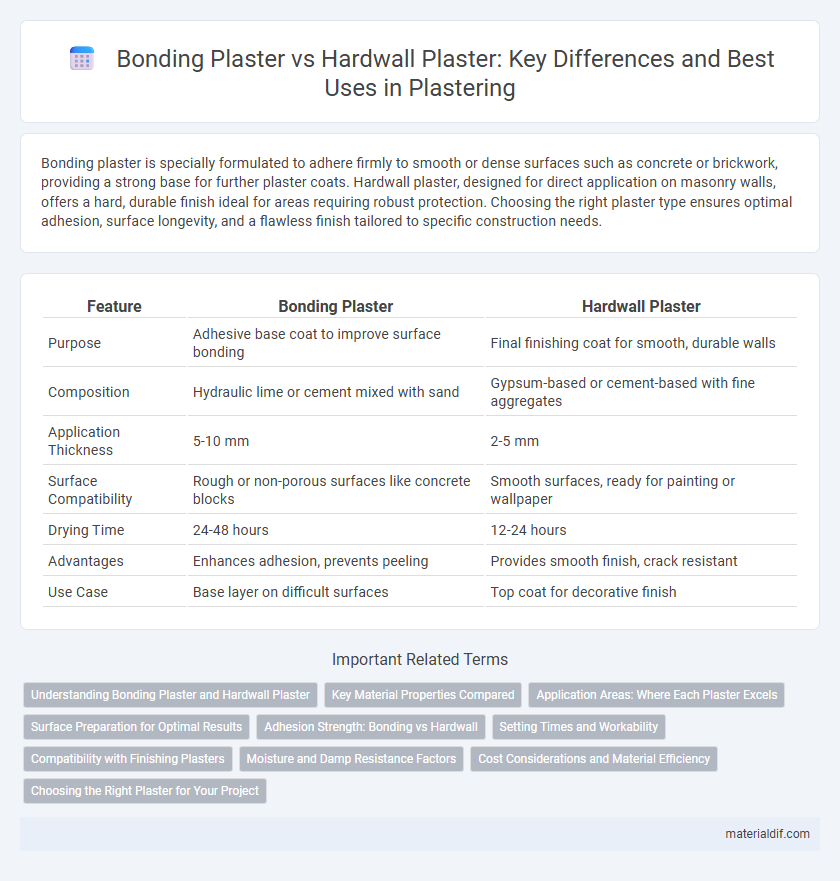Bonding plaster is specially formulated to adhere firmly to smooth or dense surfaces such as concrete or brickwork, providing a strong base for further plaster coats. Hardwall plaster, designed for direct application on masonry walls, offers a hard, durable finish ideal for areas requiring robust protection. Choosing the right plaster type ensures optimal adhesion, surface longevity, and a flawless finish tailored to specific construction needs.
Table of Comparison
| Feature | Bonding Plaster | Hardwall Plaster |
|---|---|---|
| Purpose | Adhesive base coat to improve surface bonding | Final finishing coat for smooth, durable walls |
| Composition | Hydraulic lime or cement mixed with sand | Gypsum-based or cement-based with fine aggregates |
| Application Thickness | 5-10 mm | 2-5 mm |
| Surface Compatibility | Rough or non-porous surfaces like concrete blocks | Smooth surfaces, ready for painting or wallpaper |
| Drying Time | 24-48 hours | 12-24 hours |
| Advantages | Enhances adhesion, prevents peeling | Provides smooth finish, crack resistant |
| Use Case | Base layer on difficult surfaces | Top coat for decorative finish |
Understanding Bonding Plaster and Hardwall Plaster
Bonding plaster is a fast-drying, adhesive base coat designed to prepare walls for applying heavier finishing plasters or tiles, offering excellent grip on smooth or dense surfaces like concrete and brickwork. Hardwall plaster, also known as finish or skim plaster, provides a smooth, durable, and hard-wearing finish suitable for final decorative coatings, primarily used over bonding plaster or directly on masonry for internal walls and ceilings. Understanding these distinct roles ensures effective layering: bonding plaster for strong adhesion and hardwall plaster for refined surface texture and durability.
Key Material Properties Compared
Bonding plaster contains coarse sand and hydraulic lime, providing strong adhesion and faster setting times ideal for rough masonry surfaces. Hardwall plaster, composed of fine sand and high-grade gypsum, offers a smooth finish with excellent workability but slower curing, best suited for internal walls. The key material properties differ in setting time, surface adhesion, and final texture, influencing their respective applications in construction.
Application Areas: Where Each Plaster Excels
Bonding plaster excels in application areas requiring strong adhesion to uneven or smooth surfaces, making it ideal for preparing bare brickwork or blockwork before applying finishing plasters. Hardwall plaster is suited for interior walls and ceilings, providing a smooth, durable finish suitable for painting or wallpapering in dry environments. Each plaster type optimizes performance based on surface conditions and desired finish quality, with bonding plaster used as a base layer and hardwall plaster providing a fine, decorative surface.
Surface Preparation for Optimal Results
Surface preparation for bonding plaster involves thoroughly cleaning and dampening the substrate to ensure proper adhesion, eliminating dust, grease, and loose materials. Hardwall plaster requires a sealed and primed surface, often with a bonding agent, to prevent rapid water absorption that can cause cracking or poor binding. Ensuring optimal surface texture and moisture balance is critical in achieving a durable and smooth finish with either plaster type.
Adhesion Strength: Bonding vs Hardwall
Bonding plaster exhibits superior adhesion strength compared to hardwall plaster due to its high cement content and coarse texture designed to create a strong mechanical key with rough surfaces. Hardwall plaster, formulated with finer aggregates and gypsum, offers a smoother finish but lower adhesion, making it ideal for direct application on brick or block walls only after bonding plaster is applied. The enhanced bonding capacity of bonding plaster ensures better durability and reduces the risk of plaster detachment on uneven or previously painted substrates.
Setting Times and Workability
Bonding plaster sets quickly, typically within 20 to 30 minutes, making it ideal for fixing to rough surfaces and providing a strong base coat, whereas hardwall plaster offers a longer working time of up to 90 minutes, allowing for smoother finishes on interior walls. Bonding plaster's rapid set time enhances adhesion and is suited for thicker applications, while hardwall plaster's extended workability facilitates detailed trowelling and a refined surface texture. Selecting between the two depends on project deadlines and the desired finish quality, with bonding plaster prioritized for speed and hardwall plaster favored for finish finesse.
Compatibility with Finishing Plasters
Bonding plaster provides an excellent base for finishing plasters due to its high adhesive properties, ensuring strong compatibility and preventing delamination. Hardwall plaster, while offering a robust and smooth surface, requires a suitable bonding plaster layer to optimize the adhesion of finishes like skim coats or decorative plasters. Selecting the correct combination of bonding plaster and hardwall plaster enhances the durability and visual quality of finishing plasters in interior applications.
Moisture and Damp Resistance Factors
Bonding plaster exhibits superior adherence to masonry surfaces, creating a strong base layer that resists moisture penetration due to its dense composition. Hardwall plaster, while providing a smooth and durable finish, tends to be more porous and less effective against damp conditions without additional waterproofing treatments. For areas exposed to higher humidity or dampness, bonding plaster is preferred to ensure enhanced moisture resistance and long-term wall integrity.
Cost Considerations and Material Efficiency
Bonding plaster typically costs less than hardwall plaster due to its coarser texture and quicker application process, making it a budget-friendly choice for rough surface preparation. Hardwall plaster, though more expensive, offers superior finish quality and durability, reducing long-term maintenance costs. Material efficiency favors bonding plaster for base layers, while hardwall plaster's refined composition ensures optimal performance in final coats, justifying its higher price for premium results.
Choosing the Right Plaster for Your Project
Bonding plaster, designed for rough surfaces, features a coarse texture that enhances adhesion, making it ideal for preparing walls before applying finishing coats. Hardwall plaster offers a smooth, durable finish suitable for interior walls and ceilings, providing superior strength and a refined surface for painting or wallpapering. Selecting the right plaster depends on the substrate and desired finish, with bonding plaster ensuring strong base layers and hardwall plaster delivering a polished, long-lasting result.
Bonding Plaster vs Hardwall Plaster Infographic

 materialdif.com
materialdif.com